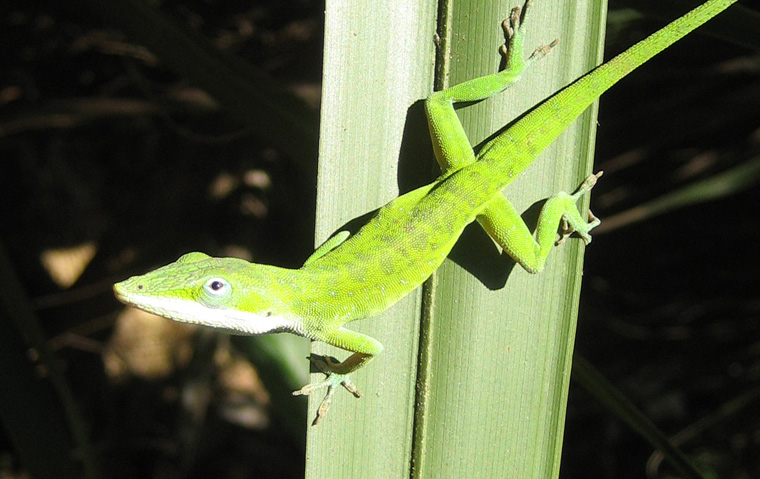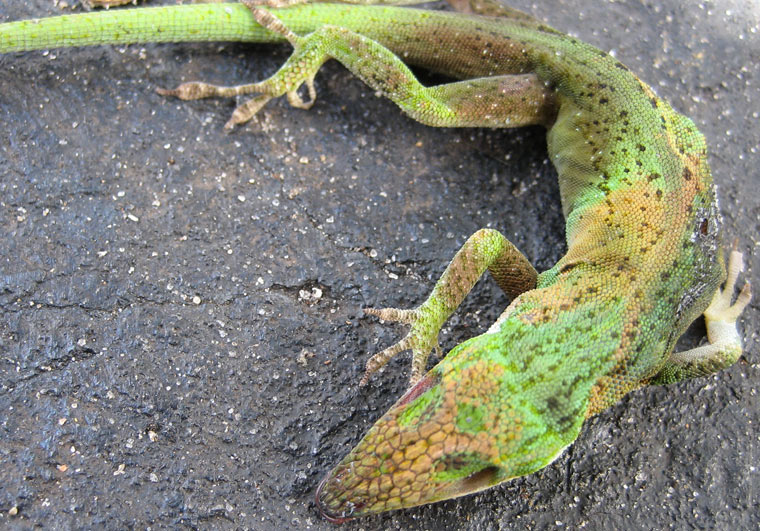-
info@aaanimalcontrol.com
Call us for help in your town
Humane Wildlife Education
Things to know about Green Anole
Need wildlife removal in your hometown? We service over 500 USA locations! Click here to hire us in your town and check prices - updated for year 2020.
The Green Anole, also known as the Carolina Anole, is a kind of lizard that has the ability to change its color to several different kinds of browns and greens. In this way, it is very much like the chameleon.

This lizard ranges from being a smaller size lizard up to medium-sized, and has a very slim body. It has a longer shaved head, and there are pointed riches that are around both the eyes and nostrils of this lizard. The males of this lizard are about 1/5 larger in size than females are, with the throat fan, or dewlap, being five times larger than you would find in the female.
The adult male can get to be about 8 inches long, where the tail makes up about 60% of its overall length. The females usually reach no farther than about 7 inches, and have the same proportion in terms of the tail.
While these are very common looking lizards in many ways, it is their ability to change colors that makes them quite dramatic. Ranging from several different hues of brown to a wide variety of greens, this lizard can easily blend in on any plant surface so that they go basically unnoticed. They even have the capability to create some yellows and blues in some of these anoles. Just so you are aware, a change in color is referred to as a phase by scientists.
These lizards are very territorial. In studies conducted by scientists, the anole has even been seen attacking images of itself in a mirror. These animals will fight to protect a certain region that they claim is their own, plus they will defend the right to the two or three females that they have courted and capped as their brides.
These reptiles are most active in the spring and fall, and become more and art during the winter. They are not true hibernate years, however. How much activity you will see is directly dependent upon the temperatures outside and how much sunlight is available.
The diet of the green anole is focused mostly on such things as crickets, spiders, flies, grasshoppers, and other kinds of anthropologists. Because of the kinds of foods that they eat, many people will keep these lizards around in their yard, because they know that they will eat such things as worms, grubs, and maggots. If you are a person who is looking to decrease these insect populations, the green anole can be a great solution.
Their reproductive patterns are quite simple. The breeding season begins in April of each year ends usually around the end of September. During the mating season, the mail will patrol its area it has claimed as its own, and displays brighter colors for females to detect. This lets them know that the male is interested in courting. While courting the female, the mail will display bright colors in its dewlaps. This structure is also used as an intimidation factor against other males. When a male is looking to reproduce with the female, he will attach himself to her dewlap to hold on during the coitus process.
About the Green Anole
Need wildlife removal in your hometown? We service over 500 USA locations! Click here to hire us in your town and check prices- updated for year 2020.
The green anole is also known as the American chameleon because, like the chameleon, it has this neat little trick of being able to change color. It doesn't have quite the same range as the original color-changing lizard, but it's still enough to make the lizard a very cool looking creature. In fact, this species of anole is the only one that is considered to be native to Florida, but that's not the only place you'll find it.

The lizard likes the South-Eastern and warm parts of the North Americas, making certain parts of North Carolina, Florida, Georgia, and South Carolina prime targets to spot them, alongside Texas, Louisiana, Alabama and Mississippi. Treed areas are best to start looking because these are arboreal lizards, but it isn't that uncommon to find them scampering across the ground too. In fact, in urban areas these creatures are commonly spotted on stairs, near railings, and also near low lying shrubs and foliage too.
They're not the largest lizards you'll come across, and their tails are usually much larger than the actual body. As much as seventy percent of their body mass can be made up of that long and slender tail, joining an equally long and slender body that usually sits between five to eight inches in length. The females are generally about fifteen percent smaller than this, and they have a white throat fan, also know as the dewlap, whereas males have a red one, and a bigger one too.
Green anoles are becoming harder and harder to spot in the wild, and if you happen to come across one, you should make efforts to protect it and make sure no harm comes to it. These little green lizards are becoming fast overtaken by brown anoles, which aren't even native to North America. With the ongoing fights for food, territory, and even mating rights, it seems that the green versions have gone into hiding somewhat, with more and more people suggesting they are becoming increasingly harder to spot. They are still there, of course, but they have been moved on, further up higher in the trees. As soon as they come back down to ground level, they're in direct competition with the invasive brown anole, which was first introduced to Florida and other areas in North America at some point in the early 1900s. At present, this fight between the two is kept in control, but it is believed that the brown anole could eventually drive away the green anole, and that's why you should treat the latter with a certain amount of respect, if you come across one.
For more information, you may want to click on one of these guides that I wrote:
How To Guide: Who should I hire? - What questions to ask, to look for, who NOT to hire.
How To Guide: do it yourself! - Advice on saving money by doing wildlife removal yourself.
Guide: How much does wildlife removal cost? - Analysis of wildlife control prices.
Animals in the attic - read about the common species.
Noises in the attic - how to identify critters by their sounds.


















